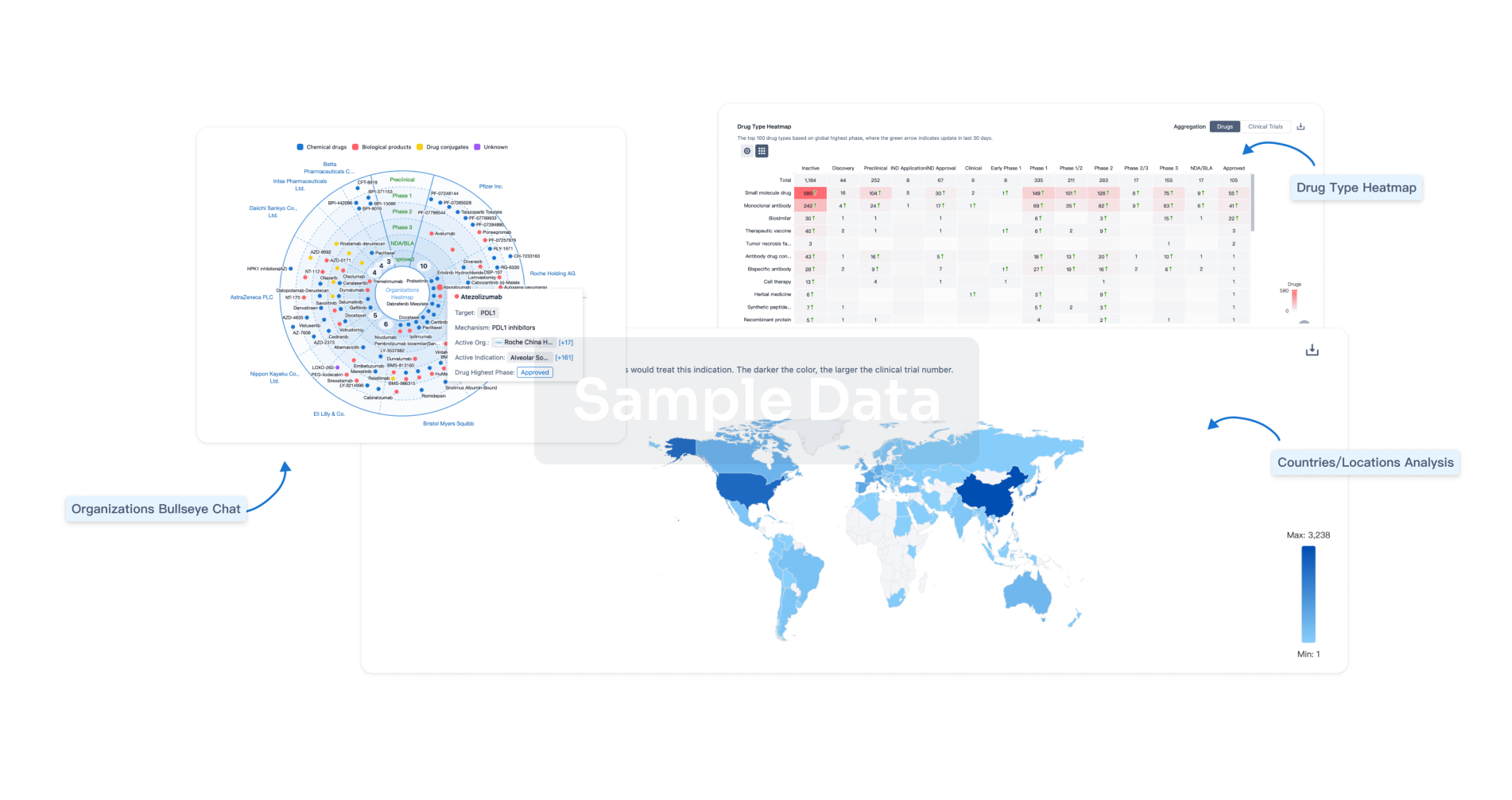Request Demo
Last update 08 May 2025
ER Positive/HER2 Low Breast Cancer
Last update 08 May 2025
Basic Info
Synonyms- |
Introduction- |
Related
2
Drugs associated with ER Positive/HER2 Low Breast CancerTarget |
Mechanism HER2 antagonists [+1] |
Active Org. |
Originator Org. |
Active Indication |
Inactive Indication- |
Drug Highest PhaseApproved |
First Approval Ctry. / Loc. United States |
First Approval Date04 Dec 2024 |
Target |
Mechanism TOP1 inhibitors [+1] |
Active Org. |
Originator Org. |
Active Indication |
Inactive Indication |
Drug Highest PhaseApproved |
First Approval Ctry. / Loc. United States |
First Approval Date22 Apr 2020 |
3
Clinical Trials associated with ER Positive/HER2 Low Breast CancerNCT06585969
A Randomised Trial Comparing Trastuzumab Deruxtecan to CDK4/6 Inhibitors in Non-luminal A, ER-positive/HER2-low Metastatic Breast Cancer
The objective of this trial, DBCG R25, will be to evaluate the effect of trastuzumab-deruxtecan versus standard of care on progression-free survival (PFS) in first-line for patients with non-Luminal A, ER-positive/HER2-negative metastatic breast cancer
Start Date01 May 2025 |
Sponsor / Collaborator |
NCT06263543
SERIES: SEquencing Sacituzumab Govitecan AfteR T-DXd In ER+/HER2 LOW MetaStatic Breast Cancer
The purpose of this research study is to see if the medication sacituzumab govitecan (SG) is effective at the currently approved dose and schedule in people who have previously received trastuzumab deruxtecan (T-DXd) for the treatment of metastatic, hormone receptor positive (HR+)/human epidermal growth factor 2 low (HER2 low) breast cancer. Although SG is approved to treat metastatic HR+/HER2 negative breast cancer, the aim of this study is to determine if SG is still effective specifically in people who have already received T-DXd.
Start Date17 Jun 2024 |
Sponsor / Collaborator |
NCT03321981
Phase 2 Study of MCLA-128-based Combinations in Metastatic Breast Cancer (MBC): MCLA-128/Trastuzumab/Chemotherapy in HER2-positive MBC and MCLA-128/Endocrine Therapy in Estrogen Receptor Positive and Low HER2 Expression MBC
A Phase 2, open-label, multicenter international study will be performed to evaluate the efficacy of MCLA-128-based combinations. Three combination treatments will be evaluated, two in Cohort 1 and one in Cohort 2.
MCLA-128 (zenocutuzumab) is given in combinations in two metastatic breast cancer (MBC) populations, Human Epidermal Growth Factor Receptor (HER) 2-positive/amplified (Cohort 1) and Estrogen Receptor-positive/low HER2 expression (Cohort2).
Two combinations treatments will be evaluated in Cohort 1, the doublet and triplet. Initially zenocutuzumab is given in combination with trastuzumab in the doublet. After the safety of the doublet has been assessed in 4-6 patients, MCLA-128 is given in combination with trastuzumab and vinorelbine in the triplet, in parallel to the efficacy expansion of the doublet.
The doublet and triplet combinations are both evaluated in two steps with an initial safety run-in followed by a cohort efficacy expansion. In total up to 40 patients evaluable for efficacy are included in both the doublet and triplet.
In Cohort 2 zenocutuzumab is administered in combination with the same previous endocrine therapy on which progressive disease is radiologically documented. A total of up to 40 patients evaluable for efficacy are included in the Cohort 2.
MCLA-128 (zenocutuzumab) is given in combinations in two metastatic breast cancer (MBC) populations, Human Epidermal Growth Factor Receptor (HER) 2-positive/amplified (Cohort 1) and Estrogen Receptor-positive/low HER2 expression (Cohort2).
Two combinations treatments will be evaluated in Cohort 1, the doublet and triplet. Initially zenocutuzumab is given in combination with trastuzumab in the doublet. After the safety of the doublet has been assessed in 4-6 patients, MCLA-128 is given in combination with trastuzumab and vinorelbine in the triplet, in parallel to the efficacy expansion of the doublet.
The doublet and triplet combinations are both evaluated in two steps with an initial safety run-in followed by a cohort efficacy expansion. In total up to 40 patients evaluable for efficacy are included in both the doublet and triplet.
In Cohort 2 zenocutuzumab is administered in combination with the same previous endocrine therapy on which progressive disease is radiologically documented. A total of up to 40 patients evaluable for efficacy are included in the Cohort 2.
Start Date15 Jan 2018 |
Sponsor / Collaborator |
100 Clinical Results associated with ER Positive/HER2 Low Breast Cancer
Login to view more data
100 Translational Medicine associated with ER Positive/HER2 Low Breast Cancer
Login to view more data
0 Patents (Medical) associated with ER Positive/HER2 Low Breast Cancer
Login to view more data
16
Literatures (Medical) associated with ER Positive/HER2 Low Breast Cancer01 Jun 2025·Breast Cancer Research and Treatment
Oncotype DX recurrence score in node-positive patients in the post-RxPONDER era: a single-institution experience
Article
Author: Han, Rachel ; Wen, Hannah Y ; Morrow, Monica ; El-Tamer, Mahmoud ; Brogi, Edi ; Thompson, Donna
01 Sep 2024·Oncology and Therapy
Exploring a Novel Approach to Spare Classic Chemotherapy in HER2-Low, ER-Positive Breast Cancer Based on Trastuzumab Deruxtecan Combined with Endocrine Therapy
Author: Sabbatino, Francesco ; Cascella, Marco ; Di Lauro, Vincenzo ; Marra, Antonio ; Di Lorenzo, Giuseppe ; Tortora, Vincenzo ; Buonerba, Carlo ; Liguori, Luigi ; Curigliano, Giuseppe ; Tarantino, Paolo ; Trapani, Dario ; Giuliano, Mario ; Arpino, Grazia ; Diana, Anna ; Scafuri, Luca ; Sciarra, Antonella
01 Jul 2024·ESMO Open
Unraveling the clinicopathological and molecular changes induced by neoadjuvant chemotherapy and endocrine therapy in hormone receptor-positive/HER2-low and HER2-0 breast cancer
Article
Author: Mension, E ; Vidal Losada, M J ; Pascual, T ; Seguí, E ; Prat, A ; Cebrecos, I ; González-Farre, B ; Bergamino, M ; Martínez-Sáez, O ; Adamo, B ; Galván, P ; Rivera, P ; Jares, P ; Mollà, M ; Muñoz, M ; Nucera, S ; García Fructuoso, I ; Vidal-Sicart, S ; Brasó-Maristany, F ; Gómez Bravo, R ; Ganau, S ; Oses, G ; Conte, B ; De Santo, I ; Sanfeliu, E ; Schettini, F ; Rodríguez, A B
Analysis
Perform a panoramic analysis of this field.
login
or

AI Agents Built for Biopharma Breakthroughs
Accelerate discovery. Empower decisions. Transform outcomes.
Get started for free today!
Accelerate Strategic R&D decision making with Synapse, PatSnap’s AI-powered Connected Innovation Intelligence Platform Built for Life Sciences Professionals.
Start your data trial now!
Synapse data is also accessible to external entities via APIs or data packages. Empower better decisions with the latest in pharmaceutical intelligence.
Bio
Bio Sequences Search & Analysis
Sign up for free
Chemical
Chemical Structures Search & Analysis
Sign up for free



